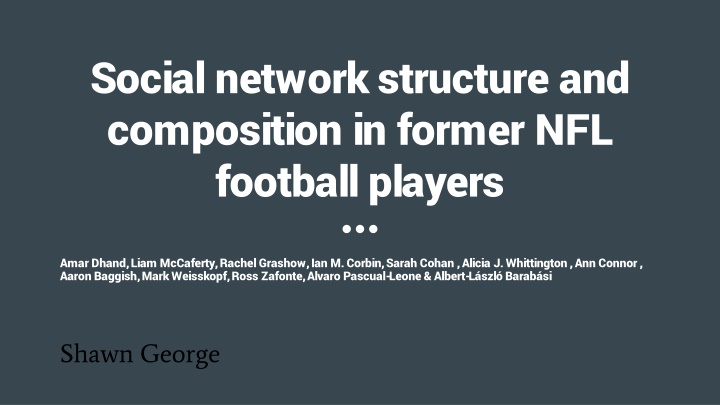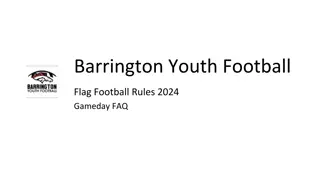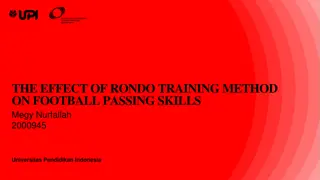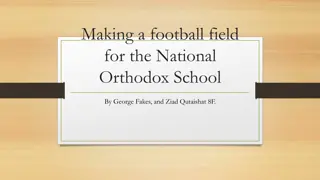
Former NFL Football Players: Social Network Structure and Health Implications
Explore the social network structure and composition of former NFL football players, examining how personal networks influence health outcomes and quality of life. The study delves into the relationship between social networks, chronic illness, brain trauma, and biopsychosocial factors in athletes, shedding light on the interplay between social connections and well-being in this population.
Download Presentation

Please find below an Image/Link to download the presentation.
The content on the website is provided AS IS for your information and personal use only. It may not be sold, licensed, or shared on other websites without obtaining consent from the author. If you encounter any issues during the download, it is possible that the publisher has removed the file from their server.
You are allowed to download the files provided on this website for personal or commercial use, subject to the condition that they are used lawfully. All files are the property of their respective owners.
The content on the website is provided AS IS for your information and personal use only. It may not be sold, licensed, or shared on other websites without obtaining consent from the author.
E N D
Presentation Transcript
Social network structure and composition in former NFL football players Amar Dhand, Liam McCaferty, Rachel Grashow, Ian M. Corbin, Sarah Cohan , Alicia J. Whittington , Ann Connor , Aaron Baggish, Mark Weisskopf, Ross Zafonte, Alvaro Pascual-Leone & Albert-L szl Barab si Shawn George
Overview Social Networks, Health, and Quality of Life Biopsychosocial Factors and Brain Trauma Clinical Pathological Characterization of Social Networks Missing in studies of contact sport athletes
Plan I. Background II. Methods III. Network Instrument IV. Data Collection V. Network Analysis VI. Statistical Analysis VII. Results VIII.Discussion IX. Football Players With Chronic Illness and Football Players Without Chronic Illness
Background: Personal Social Networks Personal Social Networks Family, Friends, Acquaintances, Interpersonal Connections Broad Effects on Health and Quality of Life Social Influence, Neurohumoral Cascades Contact Sport Athletes and Social Networks Mitigate brain trauma, quality of life Separation of the studies in social networks and brain trauma
Background: American-style football players and illness Chronic illnesses Neurodegenerative disorders, chronic traumatic encephalopathy, Alzheimer s disease, amyotrophic lateral sclerosis Additional Illnesses Cardiovascular Endocrine, mental health Physiological stress and trauma
Background: Study of Sociality Unmet need Not all players experience diseases despite similar brain trauma history Link between exposure and outcome unclear Modified by other factors that elevate or reduce risk Biopsychosocial factors Social network changes Retirement adjustments Financial status
Background: Personal Social Network Mapping Studied personal social networks of former NFL players compared to non-football US males Personal Social Network Mapping (Egocentric Network Analysis) Social support, access to resources, health habit influences, time available to socialize Examines one on one relationships Links to each other, demographic and health-related characteristics Network Structure Quantitative description of social ties (network size/density) Network Composition Characteristics of network members (percentage of kin and diversity of race)
Background: Aim Characterize personal networks of former NFL players compared to non-football controls (contextualized view) Hypothesis: Former NFL players will have constricted personal social networks compared to US controls Credibility Personal Social Network Mapping and health outcomes Stroke Multiple sclerosis
Methods Social Network survey completed by two cohorts NFL players enrolled in the Football Players Health Study at Harvard University (FPHS) in 2019 Non-football US controls enrolled in the Genes and Environment in Multiple Sclerosis Study in 2017 Former NFL Players Played after 1960 (adoption of hard shelled helmets) 336 of 3506 in the cohort responded to the survey and 33 were removed due to incomplete survey responses leaving 303 participants from this survey US Controls Asymptomatic male family members of patients with Multiple Sclerosis from a prior study 269 of 1493 completed the survey
Network Instrument Personal Network Survey for Clinical Research (PERSNET) was the instrument used and contained 3 sections Name generator Network inter-relater Name interpreter
Name Generator Name generator asked three questions Who do you typically discuss important matters with? Who do you often socialize with? Who provides support for your health needs? Participant could respond with an unlimited number of names Network size could be calculated without a ceiling
Network Inter-Relater and Name Interpreter Network Inter-Relater Participant asked to describe the presence and strength of inter-connections with the first 10 network members Name Interpreter Participant asked to describe all network members demographics, health habits, and affiliatioins with the participant
Data Collection Participants received an email and completed the survey in 10-20 minutes on a computer or mobile device Football Players received Information about their personal network Network map Social Network characteristics Information about general effects of networks on health Quality control procedure ensured surveys were completed correctly
Data Collection Demographic, football exposures, and health data were taken from the Health and Wellness Survey completed by the participants between 2015 and 2019 Race, marital status, football experience, concussion symptoms, mood, current body mass index, smoking status Chronic health conditions were taken from a prior study of the cohort of NFL players (determined by medication taken at the time) Neurocognitive affliction, pain affliction, cardiometabolic affliction, sleep affliction, Chronic health conditions assigned to US controls If they stated yes to any symptoms that chronically affected walking, use of arms and hands, vision, speech, swallowing, thinking, memory or concentration, numbness, tingling, burning sensation or pain, controlling bladder or bowel
Network Analysis Two main categories of personal network metrix Network Structure Quantitative description of the arrangement of social ties Network Composition Metrics that summarize the characteristics of network members
Network Structure: Metrics Network Size: Number of individuals in the network (excluding the participant) Density: Number of actual connections among individuals in the network divided by the number of possible connections in the network (excluding the participant) Constraint: Degree to which each network member is connected to the others in the network (additional benefits of incorporating hierarchies and strength of ties) Effective Size: Number of non redundant members in the network (conceptually an inverse metric of constraint) Maximum Degree: Highest number of ties by a network member (excluding the participant) Mean Degree: Average number of ties of a network member (indicating distribution of ties
Network Composition: Metrics Focusing on key features that define the social and health factors of the participants Diversity of Sex: Mix of men and women in the network (based on the index of qualitative variation) 0 means all network members re one sex 1 means there is an equal number of men and women Diversity of Race: Mix of races in the network 0 means all persons are the same race 1 indicates an equal proportion of each racial category ( White , Black , Other ) Percentage of Distant Ties: Percentage of people who live more than 15 miles from the participant
Network Composition: Metrics Percentage of Kin: Percentage of people who are family (including spouse) Standard Deviation of Ages: Range of ages of network members Percentage of Nnn-Exercising Ties: Percentage of people who do not exercise at least 3-4 times per week Percentage of Negative Ties: Percentage of network members who the participant reported as having a negative influence on his health Percentage of Persons who Played Organized Football Percentage of Persons who Played in the NFL
Network Composition: Metrics Homogeneity: A feature that sees whether or not participants were surrounded by individuals who were like them Majority Male Score: Number of men - number of women divided by the total number of network members (-1: majority female to 1: majority male) Proportion of Network Members with the Same Race as the Participant (0: All different race, heterogeneous to 1: All same race, homogeneous
Statistical Analysis Compared the median values and categorical distributions between the two cohorts Used multivariate linear regression to compare the groups Dependent variable was a network metric like network size Independent variables were either a cohort or the covariates Covariates: age, race, education, employment status, median yearly income, domestic status Covariates used because of differences in these categories between the two groups or they were described in previous literature to be influential on social network formation Stratifications according to race and chronic illness number and types
Results: Social Network Structure Hypothesis: Former NFL players will have constricted personal social networks compared to US controls Network Size Former football players: 2575 network members in all US Controls: 2305 network members in all Did not differ among controls and football players after accounting for age, race, education, employment status, median yearly income, and domestic status Median, Interquartile Range Football Players 8 [5,11] US Controls 7 [6,10] All other network typology metrics were not statistically different
Results: Social Network Composition Composition differed in two ways Football Players had more men than women in their networks as seen by a lower median [IQR] for Diversity of Sex NFL football players: 0.84 [0.64, 0.96] US Controls: 0.94 [0.83, 0.98] Football Players had less family members in their networks than US controls NFL football players: 40.00% US Controls: 42.86% In main comparison all other social network composition metrics were the same
Results: Social Network Composition Football Players were also asked about football affiliations Networks had a median 40.00% of members that played organized football Networks rarely had members who played professional football 196 (64.9%) had no NFL contacts 91 (30.0%) had only one NFL contact 14.29% were former teammates and coaches in organized football 0.00% of network members were former teammates or coaches at the professional level
Results: Network Structure Stratified By Race Stratified the football players cohort into White (n=222) and Black/Other (n=79) Compared each group to each other then to the US controls who were 96% White Network Structure did not differ between the race sub-groups and the controls (no difference from full group findings)
Results: Network Composition Stratified By Race Black/Other former football players had much higher diversity of race amongst network members Diversity of Race: Black/Other former football players: 0.42 [0.06, 0.78] White former football players: 0.00 [0.00, 0.00] US Controls: 0.00 [0.00, 0.26] Other Metrics Diversity Of Sex: Black/Other former football players: 0.89 [0.72, 1.06] White former football players: 0.83 [0.63, 1.03] US Controls: 0.94 [0.83, 0.98]
Results: Network Composition Stratified By Race Other Metrics Percentage of Kin: Black/Other former football players: 50.00 [22.92, 66.67] White former football players: 40.00 [22.22, 60.00] US Controls: 42.86 [33.33, 47.48] Percentage of Distant Ties (more than 15 miles from the participant): Black/Other former football players: 47.22 [28.57, 71.43] White former football players: 44.00 [20.00, 60.00] US Controls: 33.33 [16.67, 50.00]
Results: Network Structure Stratified By Chronic Illness Check whether players without health problems had more robust network structure than those with chronic illnesses (maybe they boosted numbers of players and all players have robust networks then diminish with chronic illness) Players with no illness and those with illness No structural difference Players with no illness compared to those with 1, 2, 3 or more No structural difference between all groups Players with no illness compare to those with sleep apnea, pain, cardiometabolic No distinct structural differences between all groups There is similar network structure among football players with chronic illness and those without chronic illness
Discussion Network structure differs from many studies of social behavior in populations with brain trauma and chronic illnesses Most showed diminished social relationships and constricted social networks Male dominant, friendship-oriented, and racially diverse network pattern has been seen before in studies of co-workers Work environment provides opportunities to create bonds among non-family that are homogenous over sex and education and heterogeneous in race and religion Since these homogenous ties are more resilient over time, this may be why we saw the network structure persist Large social networks seem to be a protective mechanism during stress and biological changes shown before in reducing the effects of dementia and Alzheimers Providing social support and using the strong allegiances of former athletes could help with social connectedness therapies to decrease the effects of brain trauma
Discussion: Limitations Two groups were general in the sense of that they were not matched based on age and race People who are more sociable may have been more likely to complete the survey Most people who completed the survey were older and more likely to be white which could limit generalizability Participants self reported their social networks which usually is accurate but there could have been recall bias where they may have added or omitted details from the past Network change could not be assessed as well Overall, NFL players had social networks that were compositionally different but structurally similar to those of US males
Conclusions NFL Players and US Controls have networks that do not differ much structurally but are distinct compositionally Players with chronic illness and without chronic illness still have structurally similar networks Slight differences among those with neuro-cognitive afflictions could be amplified in a more general study Compositional studies should be focused on NFL Players should seek social support and social connectedness therapy as additional treatment for brain trauma and chronic illnesses






















